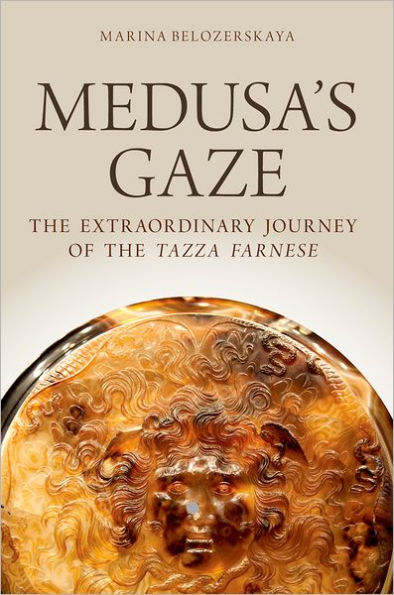Home
Medusa's Gaze: the Extraordinary Journey of Tazza Farnese
Barnes and Noble
Medusa's Gaze: the Extraordinary Journey of Tazza Farnese
Current price: $53.00


Barnes and Noble
Medusa's Gaze: the Extraordinary Journey of Tazza Farnese
Current price: $53.00
Size: Hardcover
Loading Inventory...
*Product information may vary - to confirm product availability, pricing, shipping and return information please contact Barnes and Noble
The
Tazza Farnese
is one of the most admired objects from classical antiquity. A libation bowl carved from banded agate, it features Medusa's head on its outside and, inside, an assembly of Egyptian gods. For more than two millennia, these radiant figures have mesmerized emperors and artists, popes and thieves, merchants and museum goers.
In this, the first book-length account of this renowned masterpiece, Marina Belozerskaya traces its fascinating journey through history. That it has survived at all is a miracle. The
Tazza
's origins date back to Ptolemaic Egypt where it likely enhanced the power and prestige of Cleopatra. After her defeat by Emperor Augustus, the bowl began an amazing itinerary along many flashpoints in world history. It likely traveled from Rome to Constantinople. After that city's sack by crusaders in 1204, it returned west to inspire the classical revival at the court of Holy Roman Emperor Frederick II at Palermo. The
next graced Tamerlane's court at Samarqand, before becoming an obsession of Renaissance popes and princes. It witnessed the rediscovery of Pompeii and Herculaneum, the turbulent aftermath of the French Revolution, and the birth of the modern Italian state. Throughout its journey, the
aroused the lust of Greek, Roman, Byzantine, and Mongol rulers, consoled a heart-broken duchess, inspired artists including Botticelli and Raphael, tempted spies and thieves, and drew the ire of a deranged museum guard who nearly destroyed it. More than a biography of the world's most cherished bowl,
Medusa's Gaze
is a vivid and delightful voyage through history.
Tazza Farnese
is one of the most admired objects from classical antiquity. A libation bowl carved from banded agate, it features Medusa's head on its outside and, inside, an assembly of Egyptian gods. For more than two millennia, these radiant figures have mesmerized emperors and artists, popes and thieves, merchants and museum goers.
In this, the first book-length account of this renowned masterpiece, Marina Belozerskaya traces its fascinating journey through history. That it has survived at all is a miracle. The
Tazza
's origins date back to Ptolemaic Egypt where it likely enhanced the power and prestige of Cleopatra. After her defeat by Emperor Augustus, the bowl began an amazing itinerary along many flashpoints in world history. It likely traveled from Rome to Constantinople. After that city's sack by crusaders in 1204, it returned west to inspire the classical revival at the court of Holy Roman Emperor Frederick II at Palermo. The
next graced Tamerlane's court at Samarqand, before becoming an obsession of Renaissance popes and princes. It witnessed the rediscovery of Pompeii and Herculaneum, the turbulent aftermath of the French Revolution, and the birth of the modern Italian state. Throughout its journey, the
aroused the lust of Greek, Roman, Byzantine, and Mongol rulers, consoled a heart-broken duchess, inspired artists including Botticelli and Raphael, tempted spies and thieves, and drew the ire of a deranged museum guard who nearly destroyed it. More than a biography of the world's most cherished bowl,
Medusa's Gaze
is a vivid and delightful voyage through history.

















